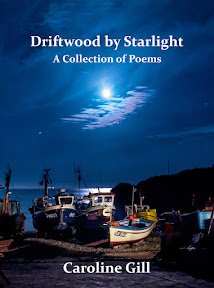We had a snowy train journey to London on Saturday to visit the Invisible Architecture Installation in The Roundhouse, Camden, curated by Antlers Press, in celebration of World Poetry Day 2013. This was our first visit to this extraordinary venue. The building itself is well worth exploring if you have the chance. You can read my previous post about it here.
 |
| Arriving at The Roundhouse ... |
 |
| ... with its steam engine shed relics. |
We were feeling pretty chilly after a train and two buses, so we warmed up with a spot of brunch at Made in Camden, the restaurant-cafe bar that adjoins the Roundhouse. We can both recommend the chipped potato wedges, and I thoroughly enjoyed the apple pancakes with passion fruit coulis.
It was soon time for the opening of Invisible Architecture, a literary 'library and listening station' curated by Nichol Keene of Antlers Press. This unique cross-cultural library (of visual and audio works) has been developed for the purpose of 'forging international links and creative collaborations between writers and publishers, swapping stories from around the world as they build their cities through what they say.'
It was this global dimension that caught my eye in the first instance. I strongly believe that writers and artists from diverse geographical and cultural backgrounds have much to share. The experience of taking part in a collaboration of this kind has many benefits.
 |
| Part of the Invisible Architecture Installation |
We walked through the dimly-lit engine shed, emerging into a central circular space. There was a display of English PEN literature against the wall. There were also a few musicians testing the sound in preparation for a later event. Some of you will know that I am fascinated by echoes, and it was fun to stand on a silver square and try out the acoustics for myself.
 |
| One of the tunnels receding from the centre |
So here we were, in a dark space that would once have housed the turntable for steam engines. The arches all round the edge led off into short tunnels rather in the way that spokes on a wheel spin outwards in all directions. It seemed to me, and this is where I would need a pigeon's eye view, that each tunnel was soon intersected by a middle wall, before extending further back into the darkness.
 |
| The Roundhouse: interior, with tunnel |
Nichol Keene, the force behind Invisible Architecture, had set a ring of fold-up chairs around the central area. Most visitors were pleased to have the chance to sit down in these extraordinary surroundings.
Antlers Press was founded as a small nomadic press by Nichol Keene in 2011. Nichol is keen to participate in projects concerning pamphlets, book design, illustrations, paperbacks, hardback books, Japanese bindings, presentation documents, portfolios, slipcases, solander boxes, photo albums, invitations, posters and fine art prints. It was good to meet her, and to learn about the hand-crafted books that she produces and about the collaborative work that she undertakes. We chatted about poetry and linguistics, about TEFL and Gertrude Stein.

Nichol Keene (supplied by Nichol)

So where does Invisible Architecture come in to the picture? The library and listening station comprised poems and prose pieces from many corners of the globe. My poetry chapbook, The Holy Place, (co-authored with John Dotson of the USA, and published by Peter Thabit Jones of The Seventh Quarry, Swansea, in conjunction with Stanley H. Barkan of Cross-Cultural Communications, New York) had been selected for inclusion in the Installation. A copy of the recent Antologia, the Orizont Literar Contemporan anthology from Romania (edited by Daniel Dragomirescu) had also been chosen for the display, along with an audio mp3 file of 'Turner's Loch Coruisk', one of my poems about Skye.
 |
| With The Holy Place and the Antologia |
There were many other items and we were able to 'borrow' these as we sat on the chairs. We could also listen to the audio files, as our recorded voices echoed through the tunnels. I encountered a huge variety of publications, ranging perfect bound volumes with photographs to small pamphlets (including one that contained a map of part of Wales). One large (A4 plus) handwritten work, Long hand, had a minimal but memorable Pepsi poem on one page.
 |
| Long hand and other selected items |
Nichol showed me some of her 'products'. The term, however, seems out of place for such finely crafted publications. There was something very special about the new pamphlet, Invisible Architecture, that had been put together by hand just in time for the Installation. It was the result of Nichol's pairing of those participants in the Invisible Architecture project who wanted to write a shared poem or piece of prose. 'The Wanderer' by Amber Massie-Blomfield and Anil Godigamuwe made an arresting opening poem, with its 'shadows that flicker' and the smell of 'the candle's light'. I bought a couple of copies of the new collection. I was also tempted by Bought, a publication in a small green envelope. It is available from the Antlers Press online shop. The narrative entitled 'The Kamikaze Dingo' is written by Toby de Angeli and illustrated by Nichol. Again, this is a novel and innovative publication, and this is the beauty of Antlers Press.
 |
| Antlers Press publications can be bought from the website by clicking here |
It was good to meet some of the other visitors to the nomadic library. One man had heard about the Installation through a news article (which he thought had been in the Daily Telegraph). Another was the author of a Turkish publication. There was a work by Oona Grimes and another by Alev Adil.
 |
| Photo of the Installation library ... |
I found myself enjoying the poetry in a day without olives is like a day by Jack Piers Scott. There is some delightful artwork on the accompanying digital album. Hallucinated Horse, another anthology on display, is a Pighog Press publication of New Latin American poets. The volume has been translated and edited by Nicole Cecilia Delgado and Tom Slingsby. There were free copies of back issues of Popshot magazine for us to take home.
 |
| ... and another |
There were times when we browsed at the display, times when we sat down to read and times when we listened to the audio files. It was a strange and positive experience.
 |
| David browsing |
Nichol had placed large empty sheets of paper and small blank cards in the centre of the circle, along with pens and a fat black marker. We were encouraged to participate by writing creatively on these. David and I attempted short Haiku.
What a great day. Thank you, Nichol!
Antlers Press



























